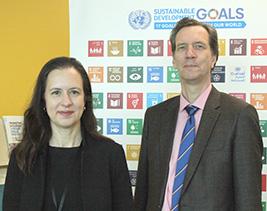Expert Voices
LDC5: From potential to prosperity

Forty-six countries in the world are classified as least developed. Ahead of the 5th UN Conference on the Least Developed Countries (LDC5) UN DESA Economists Marcia Tavares and Matthias Bruckner share challenges and opportunities facing Least Developed Countries (LDCs) today.
- 1.What are the most challenging issues facing the 46 least developed countries today and how can the global community best address them?
“The issues facing the LDCs are systemic and interconnected. These countries lag significantly behind other developing countries in terms of income, poverty, health, education, and many other aspects of sustainable development. Most have very limited fiscal resources to address these problems and are constrained in their capacity to mobilize domestic and external finances. Many are facing high levels of debt.
These financial constraints also restrict their ability to enhance their productive capacities – infrastructure, human capital, manufacturing capacity, capacity in science and technology, etc. – which in turn holds them back from embarking on inclusive and sustainable development and structural transformation.
Adding to all these interconnected challenges, and because of them, LDCs are highly vulnerable to external shocks which put hard-won development gains at risk. COVID-19, the war in Ukraine and the ever-increasing climate-related disasters are just the latest examples.
Despite these challenges, many LDCs have made considerable advances and are approaching what we call “graduation” from the LDC category. LDCs need to be supported holistically, to a much greater scale than they have been so far, so that they can effectively implement their development strategies and policies and advance towards the SDGs. Graduating countries need to be supported in the transition, to ensure their gains are not reversed. They have come a long way, but many will still face significant development gaps and multidimensional vulnerabilities.”
- 2.Why is the 5th UN Conference on LDCs in Doha important for these countries?
“The Conference is important to ensure that LDCs remain front and center in global development efforts, at a time when the world is facing many competing and compounding challenges. It is an opportunity for governments and other stakeholders from LDCs to engage with each other and with other partners, including different parts of the UN System, to explore or consolidate partnerships and opportunities for experience-sharing and peer learning. The conference is not just important for the LDCs. There cannot be a peaceful and prosperous world if we don’t overcome the immense inequalities between, as well as within, countries, as the 2030 Agenda recognizes. Hence, LDC5 is also an opportunity for partners to announce support to LDCs, which is needed to move them towards achieving the SDGs.”
- 3. The Doha Programme of Action (DPoA) is the new blueprint for LDC development in the next decade.* What are its key components and how will it impact peoples’ lives?
“The Doha Programme of Action is organized around six focus areas: investing in people (eradicating poverty, building capacity to leave no one behind); science, technology and innovation; supporting structural transformation; trade and regional integration; addressing climate change, environmental degradation, recovering from the pandemic and building resilience against future shocks; and mobilizing international solidarity and partnerships towards a sustainable graduation. For each area, there are targets and commitments to specific actions, both for LDC governments and for partner countries and organizations. Some actions directly impact the lives of people in LDCs, such as commitments for financing to strengthen education systems. Others have an indirect but equally important role, by strengthening the institutions, policies and fiscal space that will help overcome the systemic challenges described above, which in turn can enable governments to provide the services their populations need in order to meet the SDGs and their own development goals. For example, there are commitments on building the capacity of domestic financial institutions and of national statistical offices.
Closer to UN DESA’s work as secretariat of the Committee for Development Policy (CDP), the Doha Programme of Action emphasizes the importance of support for a smooth transition out of the LDC category, for those countries that have or are in the process of reaching that milestone. There is a call for support for the Sustainable Graduation Support Facility (also known as iGrad), a mechanism recently established by UN DESA and the Office of the High Representative for LDCs, LLDCs and SIDS (OHRLLS), designed to deliver integrated advisory services and capacity-building for graduating and recently graduated countries. The DPoA has also called for an enhanced system to monitor graduating and recently graduated countries by the CDP that, among other enhancements, is responsive to crises and emergencies. Both initiatives are being put in motion but need additional support to live up to their full potential.
*The final text of the DPoA was adopted during the first part of the LDC5 conference on 17 March 2022 and endorsed by the General Assembly through resolution A/RES/76/258 on April 1 of the same year.
For more information on the LDC 5 Conference taking place on 5-9 March in Doha:
 Welcome to the United Nations
Welcome to the United Nations